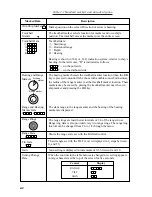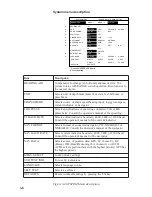
1-5
Points to consider
• Normally, a vertically distributed fish school is a better sonar
target than the seabed, because it reflects the transmitted pulse
back toward the transducer.
• In case 3, both fish schools
a
and
b
are presented. Gener-
ally speaking, however, midwater fish schools tend to be larger
than bottom fish schools and they are often displayed near the
seabed on the display.
• It is difficult to detect bottom fish when they are not distrib-
uted vertically.
Tilt angle for surface fish
Sound emitted from the sonar transducer forms a circle-shaped
beam with a width in the vertical directions (vertical beam width)
of approximately 16 degrees for Tx and 19 degrees for Rx. The
tilt angle is indicated by the angle between the center line of the
beam and the horizontal plane. Then, if the tilt angle is set to 0
degrees, the center line is parallel with the sea surface and one
half of the emitted sound goes upward, toward the sea surface.
This causes one half of the emitted sound to be reflected toward
the transducer and displayed on the screen as sea surface reflec-
tions. When the sea is calm, since the sound is reflected just like
a light hitting a mirror at a narrow incident angle, it propagates
away and the sea surface reflections become negligible.
However if the sea is not calm enough, they will become domi-
nant and interfere with observation of wanted echoes. To mini-
mize these sea surface reflections and to search surface fish
schools effectively, the tilt angle is usually set between 5 and 6
degrees so the upper portion of the beam becomes almost paral-
lel with the sea surface. When the sea is rough, it is often set to a
little larger angle.
Tilt angle 0°
Surface
Tilt angle 5-6°
Surface
Beam width Tx: 16°
Rx: 19°
Beam width Tx: 16°
Rx: 19°
Figure 1-4 Tilt angle and sea surface reflections
Содержание CSH-7
Страница 1: ...COLOR SCANNING SONAR MODEL CSH 7 ...


































